Pelargonium gibbosum
Pelargonium gibbosum (L.) L’Hér.
Family: Geraniaceae
Common names: gouty pelargonium, knotted pelargonium (Eng.); dikbeenmalva, knopmalva (Afr.),
Introduction
A tough, sprawling ground cover for dunes, sandy gardens, rockeries or pots, that flowers from summer to autumn, when very few other fynbos plants do.
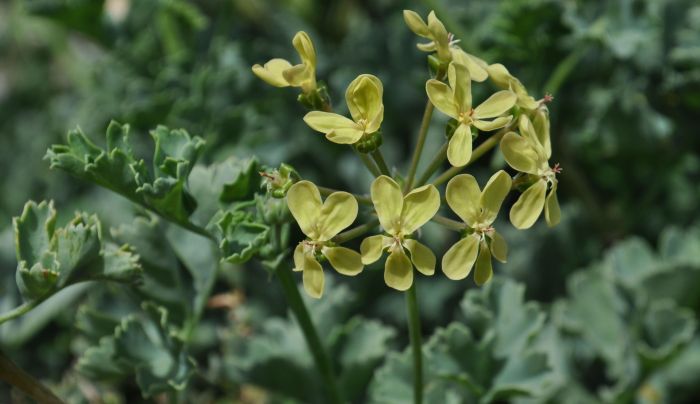
Description
Description
Pelargonium gibbosum is a dense, scrambling shrub that can grow 400–600 mm tall and, if not constricted for space, it can spread out to about 1 m wide. The stems are succulent when young, but become woody as the plant ages, and have immensely swollen nodes.
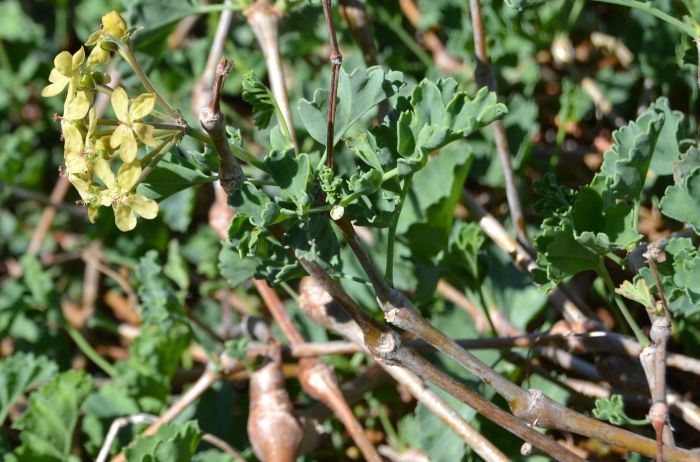
The leaves are semi-succulent, glaucous, leathery and variable in size and shape, up to 130 mm long and 75 mm broad. They may be 3- or 5-foliolate; the margins of the leaflets or segments vary between irregularly incised and toothed or lobed. The veins on the underside of the leaf blades and the margins of the leaflets may be hairy, despite the leaves generally being smooth.
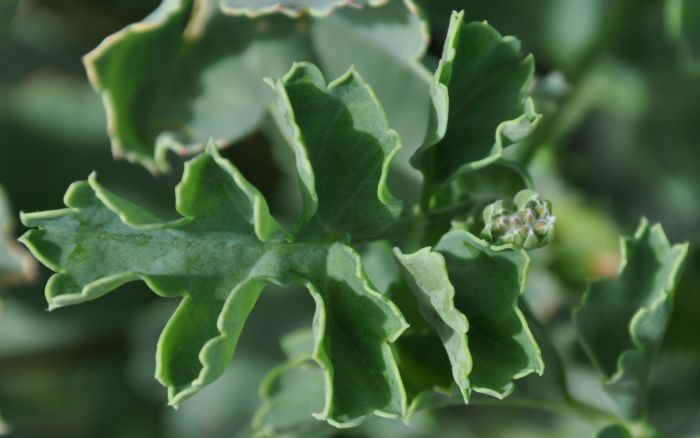
The peduncle is 40–100 mm long with a ± 15 mm diameter and is capable of bearing the umbel-like inflorescence of between 6–14 flowers. The peduncle is covered with several short and several scattered long hairs. The flowers possess a colour-range from barium-yellow to ochre-yellow, to the more common greenish yellow. Seven fertile stamens are present.
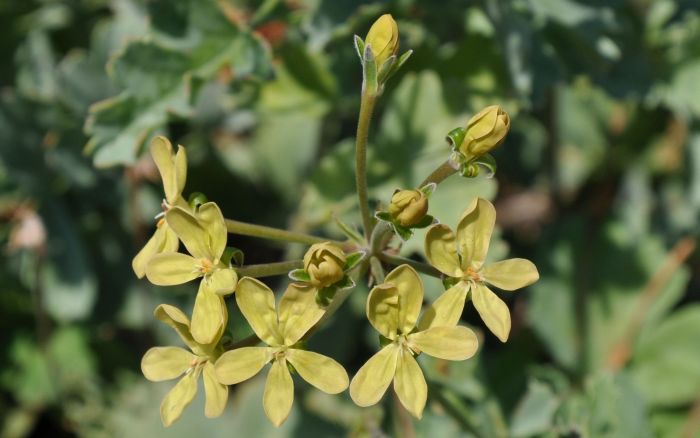
Flowering is throughout the summer, from November to April.
Conservation Status
Status
According to the Red List of South African plants website the conservation status of Pelargonium gibbosum is assessed as Least Concern (LC).
Distribution and habitat
Distribution description
The gouty pelargonium is common in sandy and rocky places near the sea, along the coast from the False Bay area on the Cape Peninsula in the Western Cape to Hondeklip Bay in Namaqualand in the Northern Cape.
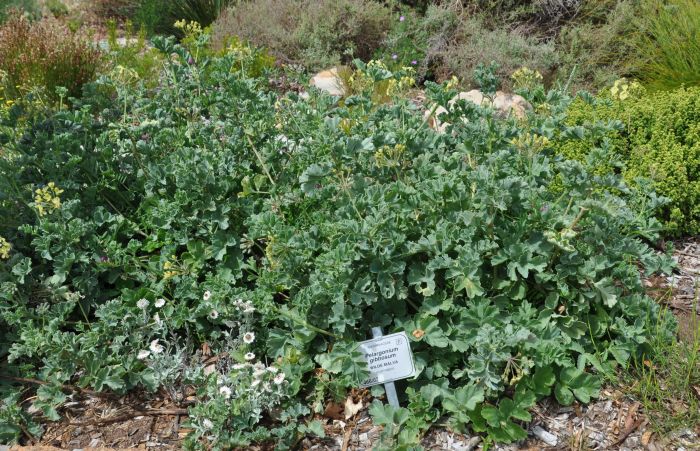
Derivation of name and historical aspects
History
The generic name Pelargonium, translated from the Greek word pelargos, meaning ‘a stork’, which refers to the seed that resembles the beak of a stork. The specific epithet gibbosum is derived from Latin and means ‘unevenly swollen’ and is in reference to the swollen nodes of the stem. The common names gouty pelargonium (gout causing swollen joints), knotted pelargonium, dikbeenmalva (thick-knee malva) and knopmalva (knobby malva) also refer to this characteristic.
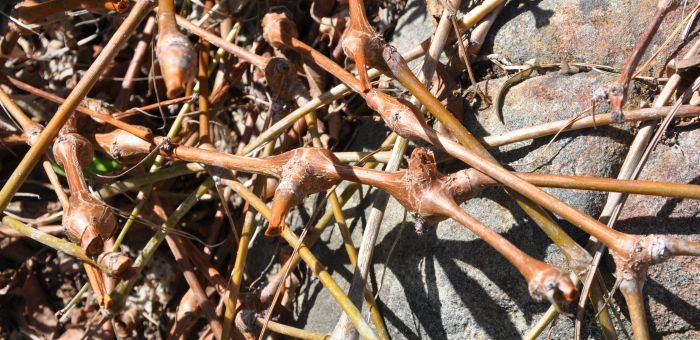
The genus Pelargonium is one of 5 genera which constitute the pelargonium family or Geraniaceae. Pelargonium consists of approximately 250 species in southern Africa alone.
Geraniaceae is a cosmopolitan family found in temperate and tropical regions such as southern, eastern and northeastern Africa, Australia, New Zealand, St Helena, Tristan da Cunha, Madagascar and Asia. Southern Africa, which is home to more than 80% of the species, is regarded as the global hotspot of Pelargonium. The highest diversity amongst members of this family is encountered in the western and southern parts of South Africa, as well as the Namaqualand-region.
The genus Pelargonium is divided into sections and the gouty pelargonium is found in the section Polyactium. This section consists of 27 species. Polyactium refers to the inflorescences of most of the species in the group, which are many-flowered and resemble a star. Species in the section generally possesses a subterranean tuber, whereas the leaves are lobed or pinnately divided.
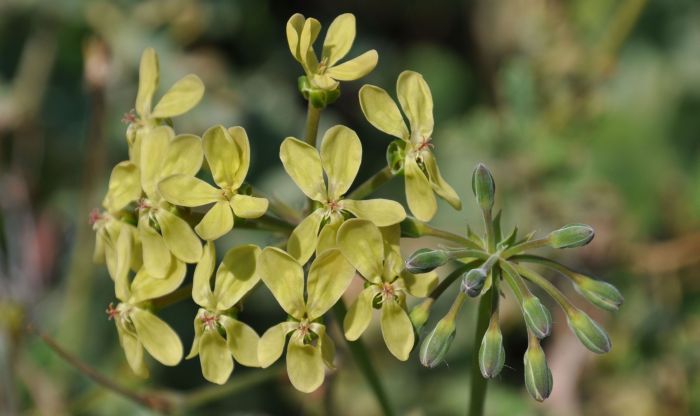
Pelargonium gibbosum has been cultivated in England since 1712 and in Holland before 1700, and pelargoniums have been studied and grown in European botany and horticulture for hundreds of years.
Some of the early botanists who published extensively on Pelargonium, like the Swede Carl Linnaeus (1707–1778) and the Dutchman Nicolaas Laurens Burman (1733–1793), described species from a number of herbarium specimens and from plants grown in gardens from all over Europe. The reason being that these botanists never once visited South Africa to study the species in their natural environment.
In what is considered by many to be the starting point of botanical nomenclature, the Species plantarum (1753) by Linnaeus, a classification system was introduced which specified that all species names ought to consist of a binary combination, where the genus names must be followed by a single epithet, i.e. Pelargonium gibbosum. Species plantarum described twenty species of Pelargonium, but all under the genus Geranium.
In August of 1759, Burman published ‘Specimen botanicum de Geraniis’. This work contained descriptions of several new Pelargonium species, but again under the name Geranium.
The Spanish botanist, Cavanilles (1745–1804) published ‘Monodephiae classis dissertationes decem’ in 1787, which saw 71 Pelargonium species described and illustrated. Cavanilles divided the then genus Geranium in 2 separate groups consisting of zygomorphic (bilaterally symmetrical) and actinomorphic (radially symmetrical) flowers. All the pelargoniums were placed in the group with zygomorphic flowers. This group was then further divided according to leaf-characters.
French magistrate and botanist, Charles-Louis L’Heritier de Brutelle (1746–1800), is credited with using the name Pelargonium first, and, although his manuscript was unpublished, he is considered by many as the author of this genus. A.P. Candolle managed to acquire the unfinished manuscript of L’Heritier, ‘Compendium generalogium’, dated 1789, after his passing. This manuscript featured descriptions of 89 species of Pelargonium (one of which was P. gibbosum), which were literally the same as descriptions used in the 1789 publication of Aiton’s Hortus kewensis (1st edition).
The Swedish botanist and explorer Carl Peter Thunberg (1743–1828) and often regarded as the father of South African Botany, produced his ‘Prodromus plantarum capensium’ (1794–1800) through extensive knowledge acquired on several collecting trips. All species of Geraniaceae were captured in volume one in 1794. Thunberg placed all species of Pelargonium under the name Geranium.
Robert Sweet (1783–1835), a British horticulturist, published 5 volumes between 1820–1830. His publications distinguished between the 5 genera of the tribe Geranieae. Several sections within the genus Pelargonium, such as Jenkinsonia, Hoarea and Campylia were raised to genus level by Sweet.
The Swedish professor of Botany, Augustin Pyramus de Candolle (1778–1841), divided Pelargonium into 12 sections in volume 1 of his ‘Prodromus systematis naturalis regni vegetabilis’. Short descriptions of 369 species and natural hybrids appeared in this 1824 publication.
Christian Friederich Ecklon (1795–1868) and Karl Ludwig Zeyher (1799–1858) were German botanists who not only spent several years collecting in South Africa, but together published ‘Enumeratio plantarum Africae Australis’. The part containing Geraniaeae was published in 1835. Several new species of Pelargonium were described in this publication which saw the various sections elevated to generic level. Most of these species later proved to be synonyms with existing ones.
William Henry Harvey (1811–1866), an Irish botanist and traveler who was also Colonial Treasurer at the Cape (1835-1842), published ‘Flora capensis’ in 1860 with O.W. Sonder. All work on Pelargonium on 163 natural species, including the division of the group into 15 sections, was performed by Harvey. Diagnostic features of each section were done according to habit, flower and leaf characteristics.
Reinhardt Knuth (1874–1957), a German professor of Botany in Berlin, published extensively on Geraniaceae in Engler’s ‘Das Pflanzenreich’ in 1912. Knuth divided Geraniaceae into 5 tribes, namely Wendtieae, Diracmeae, Geranieae, Vivianeae and Biebersteinieae. Five genera, Monsonia, Sarcacaulon, Geranium, Erodium and Pelargonium constituted the tribe Geraniaceae. Knuth not only acknowledged the 15 sections like Harvey did, but more species were added to the sections, and very importantly he also provided identification keys of the sections and it species.
Ecology
Ecology
Gouty pelargoniums have night-scented flowers with a pleasant fragrance escaping from the flowers after sunset. Although it cannot be said with certainty that this phenomenon is to attract potential pollinators, it is very likely to be the case, and suggests that the pollinator is a flying insect with a long proboscis that is active at dusk, dawn or at night, such as a moth.

In the genus Pelargonium the seed or mericarp has a feathered, tail-like structure that is coiled in a spiral arrangement. This tail causes the seed to twist around in the wind and as it does so, it drills itself into the soil. This gives the seed a better chance of germination and ultimately of survival.
Plants growing in the wild often possess a stunted appearance and are grazed by wildlife. The swollen nodes may store moisture, but are more likely to act as a means of support for the branches, and often lodge in the branches of other plants, allowing it to scramble over them.
Uses
Use
The fresh leaves and buds can be eaten fresh as a wild food, the taste is tart but palatable. No medicinal or cultural uses have been have been recorded to date.

Growing Pelargonium gibbosum
Grow
Although not regularly, if at all, grown from seed, as a species of the fynbos, a general cue can be taken from seed-propagation of other Biome-related species. It is not known whether smoke-treatment is required for freshly harvested wild-collected seed of the gouty pelargonium. The fresh seed of some Pelargonium species such as Pelargonium capitatum show good germination when sown the season following collecting after being stored at 15ºC in the cold rooms of the seed room at Kirstenbosch National Botanical Garden. No pre-treatment with smoke was required for this species. If smoke is required though, soak the seeds in a smoke-solution using Kirstenbosch Instant Smoke Plus Seed Primer discs. At Kirstenbosch we also use real smoke, by pumping the smoke from burning fynbos plants in a drum into an airtight smoke-tent containing all the sown seed-trays, once the air has cleared the trays are watered. Sow seed in late summer or early autumn in a well-draining medium. Cover the seed lightly with compost or fine sand. Once germinated, prick out the seedlings carefully not to damage the roots and pot-up once they have produced 2 or more leaves.
New plants can be grown from cuttings that can be taken throughout the year, but the best period is during the active growth phase. Take cuttings of 5–7 cm long and remove the leaves and stipules from the lower two thirds. Make a cut below the node, insert it in a powdered rooting hormone and place in a tray of coarse river sand. Place the cutting-tray in a sheltered spot and ensure that the rooting medium remains damp during this period. The cuttings will root from 2–4 weeks, after which they can be hardened-off for about 14 days. During this period the rooted cuttings can be fed with liquid fertilizer to encourage root development.
Use this species in a rockery, as a pot plant or in mixed plantings. It is best suited to fynbos and strandveld gardens in the winter-rainfall region. Water moderately if at all, during the summer months. It can also be grown as a potplant.
Plant this pelargonium with other fynbos plants such as: Coleonema album, Syncarpha argyropsis, Salvia aurea, Oedera imbricata, Felicia echinata and F. heterophylla, Chrysocoma coma-aurea, Cotyledon orbiculata, Arctotis stoechadifolia and A. hirsuta, Pelargonium capitatum, P. cucullatum and P. betulinum, Lobelia valida, Dimorphotheca pluvialis, Lampranthus aureus and L. amoenus, Cotula duckittiae, Arctotheca calendula and A. populifolia, Senecio arenarius, S. elegans and S. halimifolius, Roepera morgsana, Muraltia spinosa, Jordaaniella anemoniflora, Curio crassulifolius, Aloe succotrina, A. arenicola and A. mitriformis, Aloiampelos commixta, Conicosia pugioniformis subsp. pugioniformis and Delosperma littorale.
References
- Foden, W. & Potter, L. 2009. Pelargonium gibbosum (L.) L'Hér. National Assessment: Red List of South African Plants version 2017.1. Accessed on 2020/05/18
- Manning, J. & Goldblatt, P. 2012. Plants of the Greater Cape Floristic Region 1: the Core Cape Flora. Strelitzia 29. South African National Biodiversity Institute, Pretoria.
- Smith, C.A. 1966. Common names of South African plants. Memoirs of the Botanical Survey of South Africa No. 35. Government Printer, Pretoria.
- Stearn, W. 2002. Stearn's dictionary of plant names for gardeners. Timber Press, Portland, Oregon.
- Trinder-Smith, T.H. 2003. The Levyns Guide to the plant genera of the south western Cape. Bolus Herbarium, UCT, Red Roof Design CC, Cape Town
- Van der Walt, J J A. 1977. Pelargoniums of South Africa. Purnell, Cape Town.
- Van Wyk, B.-E. & Gericke, N. 2000. People's plants. Briza Publications, Pretoria.
Credits
Roger Oliver
Kirstenbosch National Botanical Garden
May 2020
Plant Attributes:
Plant Type: Ground Cover, Scrambler, Shrub
SA Distribution: Western Cape
Soil type: Sandy, Loam
Flowering season: Late Summer, Autumn, Winter, Sporadic/All year
PH: Acid, Alkaline, Neutral
Flower colour: Green, Yellow
Aspect: Full Sun
Gardening skill: Easy
Special Features:
Horticultural zones









Rate this article
Article well written and informative
Rate this plant
Is this an interesting plant?
Login to add your Comment
Back to topNot registered yet? Click here to register.